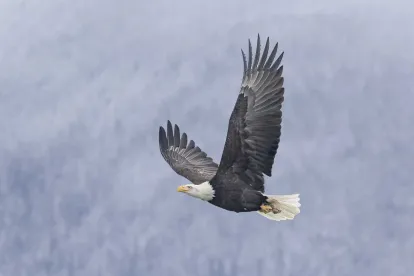The U.S. Fish and Wildlife Service (USFWS), on 29 September, released a significant rulemaking proposal that seeks to ease the permitting process to authorize incidental take of bald and golden eagles. If finalized, USFWS’s proposed rules would provide a much needed streamlined permitting pathway for developers of many critical energy infrastructure projects—including wind energy facilities and electric transmission lines—that have potential to impact bald and golden eagles.
Background
The Bald and Golden Eagle Protection Act (BGEPA) prohibits anyone from “taking” a bald or golden eagle without a permit. A “taking” or “take” in this context includes killing, harming or disturbing an eagle. This prohibition applies to both intentional takes as well as “incidental” takes – i.e., takes incidental to otherwise legal activity.
USFWS first issued BGEPA regulations for incidental take permits in 2009, and substantially revised those rules in 2016. The current rules require all applicants to apply for individual permits. Applicants for take permits must conduct pre-construction surveys, post-construction mortality monitoring, and engage a third party to conduct monitoring to ensure permit compliance. While individual permits can last up to 30 years, the USFWS conducts reviews of permit implementation every five years, which cost US$36,000, plus a US$8,000 administrative fee for each individual permit. Permittees under this program must meet strict requirements; for example, when a permitted program is predicted to take more eagles than USFWS deems sustainable, the permittee must offset excess takes by either (1) reducing another form of eagle mortality or (2) increasing the carrying capacity of the eagle population.
Wind energy facilities can be a cause of incidental take. Given the strict liability provisions under BGEPA, developers proposing projects that may incidentally take bald and golden eagles, like wind farms, can apply for individual permits. However, issuance of incidental take permits for wind energy projects has not kept pace with the industry: while there are more than 1,000 wind-energy projects on the landscape, the USFWS has issued only 26 permits since 2016.
The Proposed Rule
On 29 September, the USFWS announced its proposed updates to the eagle take permit program. The significant proposed changes include (1) establishing a general permit program, which would streamline the process for obtaining and complying with a take permit, and (2) reducing oversight requirements for individual permits.1
1. Establishing General Permits
The USFWS proposes establishment of a general permit program for certain activities that commonly result in eagle takes: (A) wind energy projects; (B) power line infrastructure; (C) certain categories of eagle disturbance activities; and (D) certain categories of eagle nest takes. The USFWS proposes a maximum length of five years for these general permits. The proposed general permit application fee is US$500, with an additional fee of US$2,625 per turbine for wind projects. Under the proposed rule, general-permit applicants would self-identify eligibility and register with the USFWS, certifying that they meet eligibility criteria and will implement permit conditions and reporting requirements.
A. General permits for incidental take of eagles by wind energy projects
To qualify under this new general permit, all turbines associated with a project must be located in areas that fall under the “relative abundance” thresholds provided in the regulation and USFWS data. According to the proposed rule, relative abundance is the average number of eagles expected to be seen by a qualified person who observes for eagles for one hour at the optimal time of day for detecting the species and travels no more than one kilometer during the observation session. The USFWS estimates that nearly 80% of all existing wind energy turbines in the United States are located in areas under these relative abundance thresholds and thus eligible for a general permit under this rule.
Wind energy projects covered under the general permit would be required to continue monitoring for eagle takes and report any eagle takes to the USFWS annually. Additionally, if the permittee discovers the take of three eagles of the same species during the tenure of the general permit, the permittee would be required to notify the USFWS within two weeks of discovering the third eagle and implement adaptive management measures. If a permittee discovers the take of a fourth eagle of the same species, it will no longer be eligible for future general permits for incidental take, and an individual permit will be required.
B. General permits for incidental take of eagles by power lines
The proposed rule would establish a general permit for incidental take of eagles for power line infrastructure that meets the following conditions: (1) new construction and reconstruction of pole infrastructure is electrocution-safe; (2) construction and reconstruction of transmission lines considers eagle nesting, foraging, and roosting areas; (3) reactive retrofit strategies are developed to retrofit high-risk poles when eagle electrocution is discovered; (4) proactive retrofit strategies are developed to convert existing infrastructure to be electrocution-safe; and (5) collision-response strategies are implemented for all eagle collisions with power lines.
C. General permits for eagle disturbance
The proposed rule would authorize general permits for certain categories of activities that result in disturbance of bald eagles, including: construction activities; linear utilities; alteration of shorelines; vegetation and timber practices; motorized recreational activities; non-motorized recreational activities; aircraft operations; and blasting and other loud noises.
D. General permits for eagle nest takes
Finally, the proposed rule would authorize general permits for eagle nest takes when taken for emergency reasons, health and safety reasons, or removed from human-engineered structures.
2. Reducing Oversight Requirements for Individual Permits
The USFWS also proposes to remove the current requirement that USFWS conduct permit reviews every five years. Instead, the USFWS will initiate permit reviews as needed based on information received from third parties. Relatedly, under the proposed rule, the cost of the individual permit would be adjusted from US$36,000 to US$28,000 and a one-time US$8,000 administrative fee. Rather than being charged an additional US$8,000 administrative fee every five years, permittees would only be charged this administrative fee if significant changes to the permit are required as a result of a permit review.
Finally the USFWS proposes to remove the existing third-party monitoring requirement from individual permits. In its place, the USFWS explains that it will rely on the certification requirement in all applications and the reporting requirement that all information submitted is complete and accurate subject to criminal penalty under 18 U.S.C. § 1001.
Conclusion
The proposed rule was published in the Federal Register on 30 September, 2022, and the public comment period will be open for 60 days.






 />i
/>i

